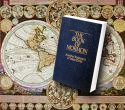
FAIR is a non-profit organization dedicated to providing well-documented answers to criticisms of the doctrine, practice, and history of The Church of Jesus Christ of Latter-day Saints.
(Created page with "{{Articles FAIR copyright}} {{Articles Header 1}} {{Articles Header 2}} {{Articles Header 3}} {{Articles Header 4}} {{Articles Header 5}} {{Articles Header 6}} {{Articles Head...") |
No edit summary |
||
| Line 5: | Line 5: | ||
== == | == == | ||
{{QA label}} | {{QA label}} | ||
{{:Question: Is there an "official" or revealed Book of Mormon geography?}} | |||
</onlyinclude> | </onlyinclude> | ||
{{endnotes sources}} | {{endnotes sources}} | ||
| Answers portal |
| Book of Mormon Geography |

|
|
Geography: DNA: Archaeology: Lamanites in North America: Other: |
J. Reuben Clark |
This is one of many issues about which the Church has no official position. As President J. Reuben Clark taught under assignment from the First Presidency:
|
Harold B. Lee |
Harold B. Lee was emphatic that only one person can speak for the Church:
|
First Presidency |
This was recently reiterated by the First Presidency (who now approves all statements published on the Church's official website):
In response to a letter "received at the office of the First Presidency of the Church of Jesus Christ of Latter-day Saints" in 1912, Charles W. Penrose of the First Presidency wrote:
|
References |
Notes
|

Leaders of the Church have long been clear that there is no "official" or "revealed" geography for the majority of Book of Mormon events, including those which take place in the New World:[1]
There is a great deal of talk about the geography of the Book of Mormon. Where was the land of Zarahemla? Where was the City of Zarahemla? and other geographic matters. It does not make any difference to us. There has never been anything yet set forth that definitely settles that question. So the Church says we are just waiting until we discover the truth. All kinds of theories have been advanced. I have talked with at least half a dozen men that have found the very place where the City of Zarahemla stood, and notwithstanding the fact that they profess to be Book of Mormon students, they vary a thousand miles apart in the places they have located. We do not offer any definite solution. As you study the Book of Mormon keep these things in mind and do not make definite statements concerning things that have not been proven in advance to be true.[2]
As the Encyclopedia of Mormonism notes:
The Church has not taken an official position with regard to location of geographical places [of the Book of Mormon].[3]
Because there is no official revealed information on this topic outside of the Book of Mormon text itself (see this page for further statements from Church leaders and writers about geography), students of the Book of Mormon have proposed a number of models to illuminate what the text tells us.[4]

FAIR is a non-profit organization dedicated to providing well-documented answers to criticisms of the doctrine, practice, and history of The Church of Jesus Christ of Latter-day Saints.
We are a volunteer organization. We invite you to give back.
Donate Now